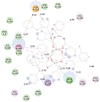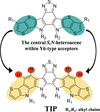issue contents
April 2022 issue

Cover illustration: The preparation and structural investigation of seven solvates of the antihypertensive drug olmesartan are described. All the structures were found to be isostructural and the supramolecular arrangements are held in a similar way by strong N—H⋯O hydrogen bonds. See Grosu, Martin, Turza, Miclaus, Kacso & Borodi [Acta Cryst. (2022), C78, 240–249].
research papers




 access
access










 journal menu
journal menu
























